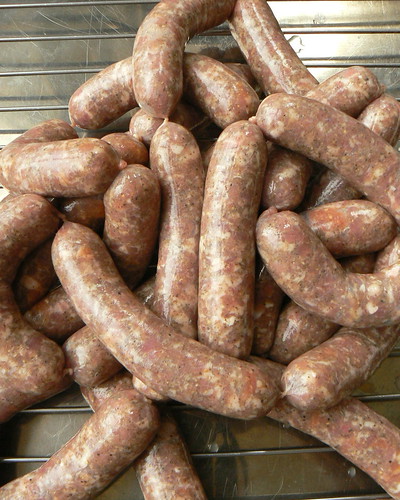
Savory Breakfast Sausage Recipe.
After several weeks of research, thirteen pounds of pork shoulder, numerous taste tests, I collated the comments (i.e. what's that flavor?), tabulated the results, and today I present to you the Ultimate Breakfast Sausage Recipe.
I sent myself on this quest, after longtime reader, George from Ohio, wrote for a recipe. I felt bad (and never responded) because I did not have an answer. Well George, this one's for you, The Ultimate Breakfast Sausage recipe.
[BEEP BEEP] Wait, stop the Dictaphone, I'm getting a message across the Telex. It's the Beard Foundation.
[CLICKING NOISES, THE PHONE RINGS]
Yes, yes I understand.....But I have documentation showing the decline of American Cuisine starting in 1896....Uh-huh, why yes there was a distinct American cuisine that started with the earliest settlers, but this is about a truly American sausage, and I have discovered....
[INDISTINCT MUMBLING]
Ok I will tell them.
[THE PHONE RINGS AGAIN, IT CONTINUES TO RING]
Sorry about the interruption, it has been brought to my attention, that I do not have the Ultimate Breakfast Sausage Recipe, it actually rates only fifth or sixth...out of seven.

When I started my search the first thing I did was scratch the word "Breakfast" and replaced it "Country." We have been making Country Sausage in America for centuries. In his book Cutting-up in the Kitchen, Merle Ellis* decribes Country style sausage with sage. He tells how his grandma would stuff the sausage mixture into 3 x 12" muslin bags called 'pokes," then simply cut rounds as needed for breakfast. Jerry Predika's The Sausage-Making Cookbook, lists nearly thirty recipes for country or farmer's sausage. But the oldest recipe I found was in Mary Randolph's The Virgina House-Wife. First published in 1824, it's America's first cookbook. Randolph's recipe, found on page 66, calls for salt, pepper and sage. She notes that "(The) Sausages are excellent made into cakes and fried." Let's start there.
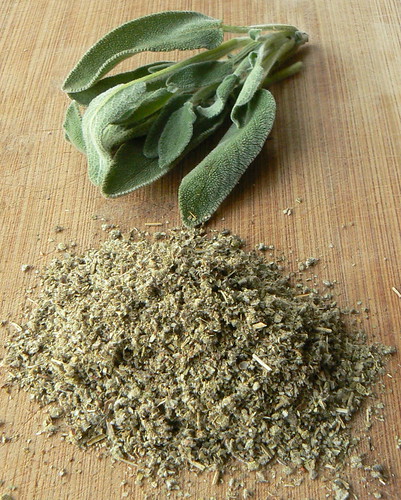
Old Sage
Just like many foodies before me, I have chortled at the notion of using dried herbs. Fresh is better and with the convience of modern groceries (and gardening) I can get a variety of fresh herbs. But wait, did I just pay three bucks for an ounce of "fresh" sage? Yeouch. I decided once and for all to compare fresh to dried, and I have concluded that dried is fine for sausage. For my tastes using 1/2 the measurement of dried sage for fresh is good. So, am I buying dried sage? No, I did for this project, but I grow my own. Do I carefully harvest and dry sage leaves? No...
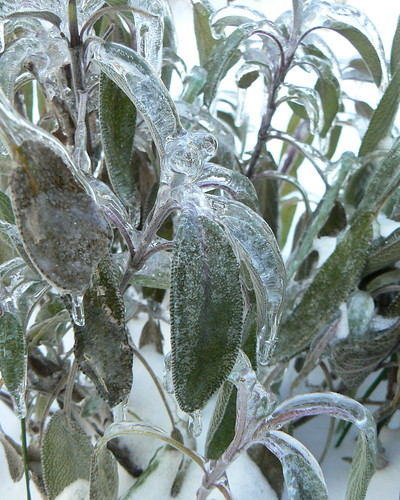
I just grab whatever I can find in the snow and go with it. Growing sage is pretty easy, it's a perennial(it comes back year after year) and as you can see you can grab leaves from it anytime.
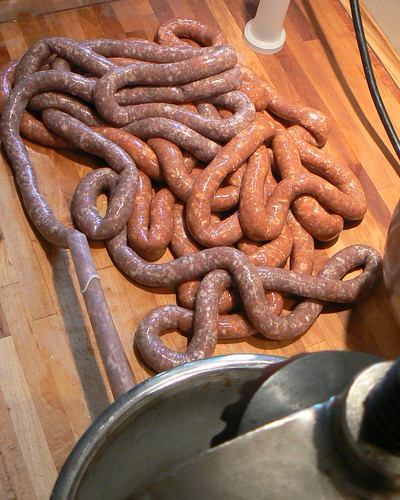
With Randolph's recipe in hand I made some sausage. Was it the Ultimate Breakfast Sausage? Not really. I started thinking about the flavors I wanted, I asked my wife (Bonne Femme), what she thought should go in it, and here's the recipe we finally settled on for the Ultimate Breakfast Sausage:
Savory Breakfast Sausage
1350g/3lbs Pork shoulder ground fine
20g/ 3tsp Salt
15g/ 1T Black peppercorns
18g/ 1/2c Dry rubbed sage
6g/ 1T Whole coriander
60g/2oz/ 1/4c Maple Syrup
120g/4oz/1/2c Water
Finely grind the spices with the salt and mix well into the ground pork. Beat in the maple syrup and water. Continue to stir until the mixture comes together. Stuff into sheep casings or form into 1 pound logs (Pokes). The logs can be wrapped and frozen then later sliced as needed. Fry until pink, do not overcook.
Here are a few additions I tried along the way:
Winter Savory. Another easy to grow perennial, it's flavor is a combination of Rosemary, thyme and mint. But be careful, this stuff is strong, no more than a gram per pound.
Fenugreek seeds. Ever since I read that the extract of this seed is used in maple flavoring, I wanted to use it. While the aroma is very 'mapley' it doesn't come through as well as actual syrup. This spice is an essential ingredient in many curries. It's a form of clover (Greek hay), I might try to grow it this year. In the sausage try 2 grams ground per pound.
Kelp powder. Don't tell the vegetarians I'm using kelp in sausage. Bonne Femme got this stuff for the dog, but I'm using it in bread baking. Scientifically it's Laminaria digitata, a form of brown seaweed. It's known as a superfood and it's loaded with iodine. I tried it in sausage because it enhances the umami, or as the pros say, it add some zip. Folks over in Japan have long known that seaweed triggers our taste buds just like monosodium glutamate. I don't really care one way or the other about MSG, but since I didn't have any, and I did have some kelp, I tried it out. It's noticeable, I want to play around with it some more. Try 1/4 teaspoon per pound.

So it's the Ultimate Breakfast Sausage Recipe, right? Well maybe not. While I was working on this project I happend to thumb through John Thorne's Mouth Wide Open: A Cook and His Appetite. In it he states:
"'Ultimate' recipes are something you earn, not find."
Boy if that ain't a sucker punch to the gut. I spend all this time cramming recipes through my "test kitchen" when I realize it's gonna take me a long time to perfect the Ultimate Breakfast Sausage recipe. In the meantime, YOU can make one too. You've got the basics, start with the three ingredients, and then think would what would taste good. Basil? Garlic? Thyme? Make it yours and it's gonna be good. If you have any questions I'm happy to help.

Cheers.
Resources used in this article (Links to WorldCat.org)
*Merle Ellis, I think he's still around, but the seventies and eighties he wrote a syndicated column called "The Butcher." He had a TV show and a catalogue, A true food star. I like his no nonsense approach. One day I wanna be in a movie where I try all his recipes. It's called MAC and Merle.
Try to find Ellis' Great American Meat Book, it pretty interesting.
The Sausage-Making Cookbook by Jerry Predika
The Virgina House-Wife by Mary Randolph, annotated by Karen Hess
About Savory and Sage, The Herbfarm Cookbook by Jerry Traunfeld
About Fenugreek, Cooking with Herbs and Spices by Andi Clevely et AL.
About Seaweed and MSG, The Oxford Companion to Food by Alan Davidson
Mouth Wide Open: A Cook and His Appetite by John Thorne, Matt Lewis Thorne
15 March, 2010
The Ultimate Breakfast Sausage Recipe
30 December, 2009
Top takes of 2009
As this year rolls to a close here's a look back to some of my favorite recipes in 2009.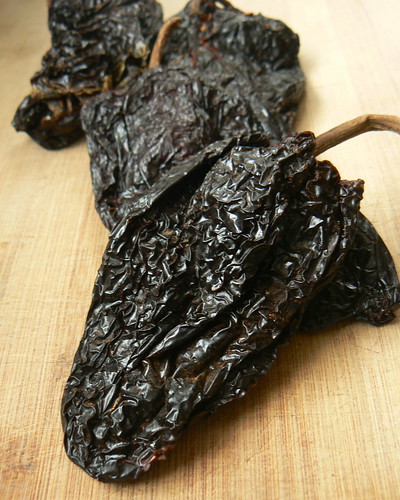
Chorizo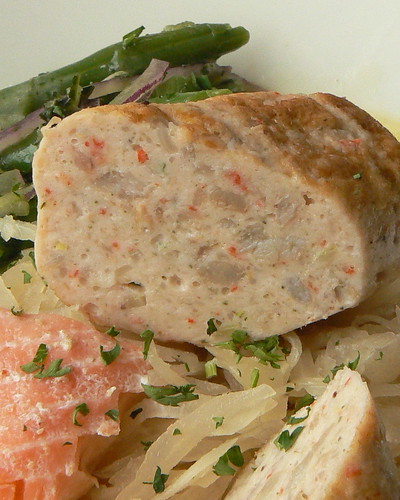
Seafood Sausage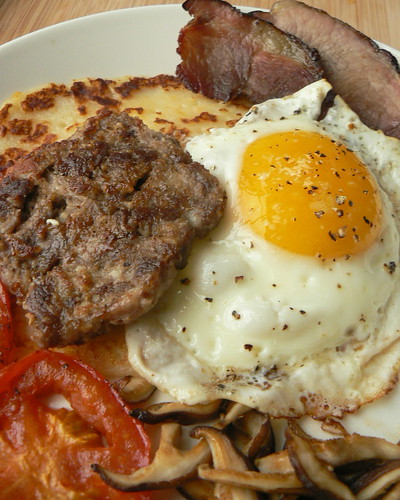
Scottish Breakfast
Carnitas Pibil
Thai Curry Chicken Sausage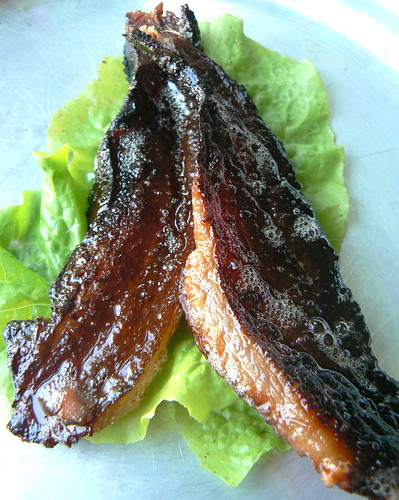
Taking Back Bacon
Thanksgiving Sausage
Happy New Year everybody. Live life happy. And cook!
Cheers.
08 October, 2009
Taking Back Bacon

Home-made Bacon, The Perfect Gift.
I am ready to give you a recipe for bacon. What's that? You already have one? I mean curing bacon, at home, and I want to put the bacon hoopla to rest right now: You're going to make this with the cheapest piece of meat you can find and cure it with ingredients you have in the kitchen right now. And it's gonna taste like bacon which means it's gonna taste great.

Over the past few months I have cured nearly forty pounds of bacon. I have brined it, dry rubbed it, used nitrites, not used nitrites, forgot sugar, hot smoked, cold smoked, no smoked, and then fed it all to my family and friends. So far nobody has complained.
But let's forget get all that for a moment. I want to talk to you about bacon, I want to make sure you know it's okay to strip away all the hype surrounding bacon and pork belly right now. Long after the Baconfests and BaconCamps and the "Current culinary couture (that)centers on () pork and farmers," go away, bacon will still be here for you. I want assure you that you can find bacon happiness in your own kitchen. So go head and chuck the rock star chefs and their rumaki redux, cancel your mail-order of double applewood smoked artisinal bacon from Oklahoma, it's time to take bacon back.

Bacon is our American heritage. Mariani reports in the Dictionary of American Food and Drink that "Bacon has long been a staple of households because of a long history of pork consumption and hog butchery."
Indeed.
Waverly Root, in the encyclopedic tome, Food notes "America was built by pioneers and pigs. The covered wagons which started west, even before the Gold Rush usually carried seventy-five pounds of bacon per adult."
Now I could go on quoting sources stressing the historical importance of salting and smoking pork as a matter of preservation and economics, but I think that would miss the most important connection between us and bacon, the taste. Salt, sugar, smoke, and fat. Are you ready to make some bacon?

The Belly
As I have mentioned in a previous post the hardest part of the bacon operation is procuring pork belly. Grocery stores usually don't carry the cut so you got to be creative. I get mine from a small meat packer that sells retail, look for a packer in your area. You could check with your favorite pork purveyor at the farmer's market. Also stores specializing in Asian or Latino food are good bets. Last week I got pork belly already cut into 2-1/2lb pieces at CAM Asia Supermarket in Columbus. When choosing a belly go for the thickest you can find, that'll make the best bacon. At the meat packer I have to buy a whole piece which can be 10 to 12 pounds and I have written the recipe for that amount. In terms of price I pay 1.39/lb at the packer, CAM charged us $2.25/lb, the price will go up from there.

The Cure
Sugar, salt and belly and you got bacon, the rest is icing. But icing is good sometimes, no? I have come to favor a combination pepper mustard, coriander, allspice, and bay (AKA pickling spice)to cure bacon and ham. But really salt and sugar is it; I used to believe that sugar (especially for brining) was not necessary but after side by side comparisons, sugar balances the salt.
Another important ingredient is curing salt. This ingredient goes by different names such as Insta cure #1, Prague Powder #1, DQ Cure, and it is 6.25 percent sodium nitrite. You can get this stuff mail order, but I buy mine at The Spice House.
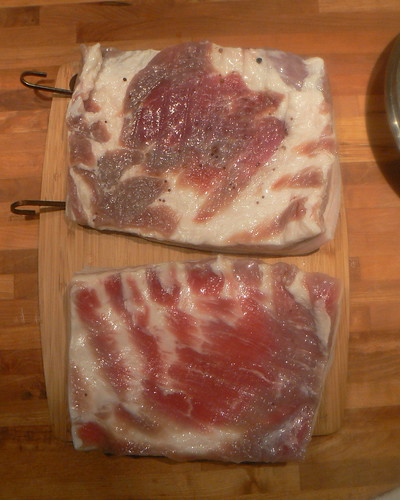
Top piece cured with curing salt bottom piece without.
I have no problem using this stuff, it contributes to flavor, color and it substantially increases self life. Plus, since I'm certified in food service sanitation by the state of Illinois, I can't recommend cold smoking meat without using nitrites. But, back to what I said in the beginning, do you have pink salt in your kitchen? Do you need it to make bacon? Let's move on.
There are two ways to cure bacon,
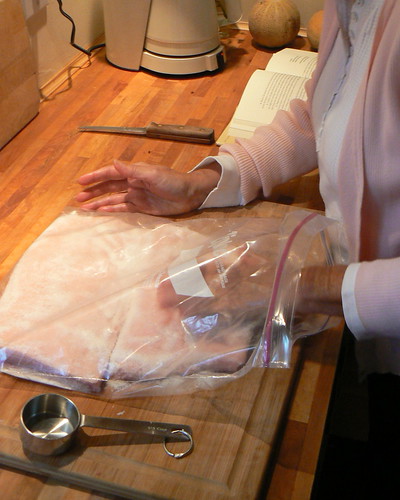
applying a dry rub
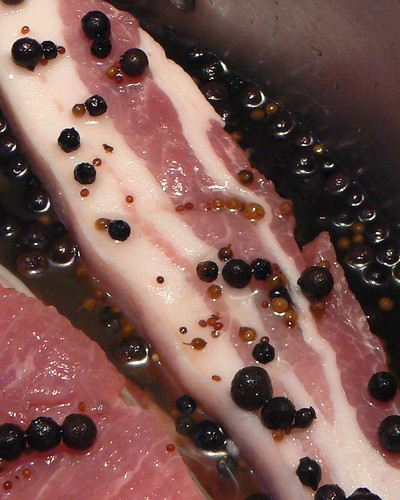
or pickling in a brine.
I've done dry rub lots of times it's quick to start and it doesn't take a whole lot of room in the fridge. The first bacon I made was with a recipe from Charcuterie which procribed a dry rub. But I have come to like the pickle because the cure time is shorter and the cure is more thorough than the dry rub.
The smoke
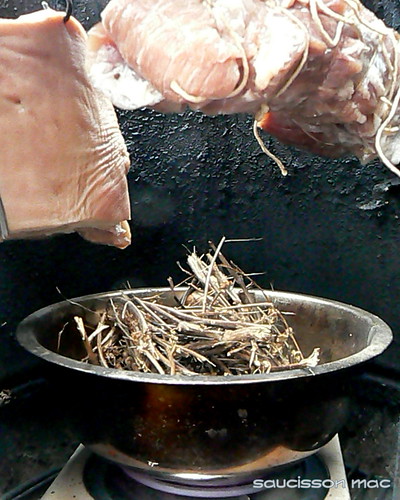


Smoke is a visceral obsession. It is an olfactory memory that has collected and compounded in the human being for millions of years. The smell stands for warmth, safety and prosperity. Taking in this memory welted to fat, salt and sugar connects us to all who have come before us. It's the smile at the corners of our eyes.
So, is it important?
If you have a grill of some type then you should be smoking bacon. I have smoked bacon in many different ways, and I have always come away with the same conclusion: I don't like making a big production out of it. Please understand I am not some sort of artisinal baconphile, I don't dial my recipe on single grains salt or handfuls of hand hewn sawdust or multiple days of cold smoking. Minor tweaks I cannot do. I'm big picture: Look like bacon? Taste like bacon? Too salty? For finishing bacon I like hot smoking. I set an fire in the grill/smoker at 250F and cook until the bacon gets to a internal temperature of 150-160F. In terms time, it's usually two hours. Get some wood chips from the hardware store, cut up any sort of hardwood that you may have laying around, Two hours of gentle smoke makes a fine bacon.


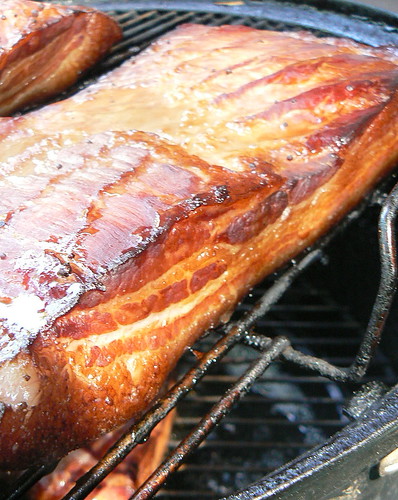
Bacon finished in the oven without smoke is a perfectly delicious endeavour. In England cured belly without the smoke is called green bacon.
The recipe for Bacon
1 pork belly 10-12 pounds, skin on
Brine:
5 L water
440g Salt
50g Curing Salt*
450g Sugar
Pickling Spice
16g Black peppercorns
11g Allspice
10g coriander
10g brown mustard seed
4 bay leaves
*You can substitute an equal amount of regular salt for curing salt.
Mise en Bacon: Find non-reactive container(s) to brine belly. Trim into manageable squares. Save scraps for sausage, lard, or just throw them in the pickle.
Combine water, salt, sugar and pickling spices(if using, remember they're icing) and boil for one minute. The brine needs to cool (Not in the fridge) to 70F.

Make an ice bath in the sink or use ice paddles to cool quicker. I made ice paddles by freezing water in one quart milk jugs.
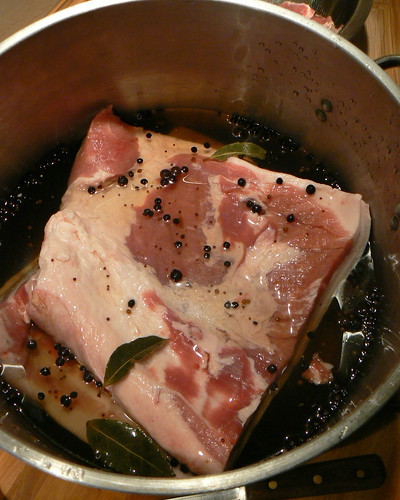
Immerse belly into cooled brine in non-reactive containers, refrigerate. Cure for three days.
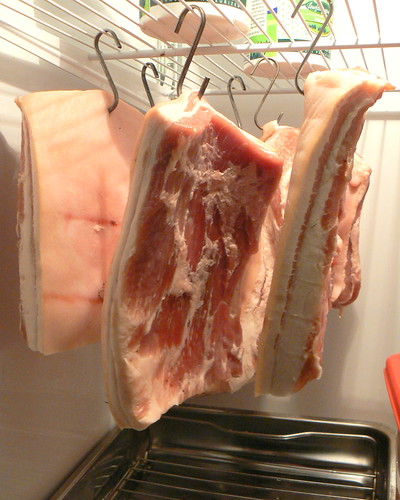
The bacon needs to dry before smoking. Pull it from the brine and let it rest on a rack or dangle for a day. The stainless steel hooks pictured above came from an IKEA pot rack.
When you are ready to finish the bacon heat Smoker/grill/oven to 250F. Cook bacon to Intemp of 150F. About two hours.
Allow the bacon to cool, but while warm remove the rind (skin). You can save the rind for flavoring soups or beans.

Once cooled wrap and refrigerate. You can fry some up now, but it tastes better the next day.
I can't tell you exactly when bacon goes bad, I have kept bacon (cured with nitrites) in my fridge for months. For the stuff cured with just regular salt I start noticing change after a couple of weeks. Therefore I recommend you freeze this bacon after ten days.
SO you got all this bacon what are you going to do with it?
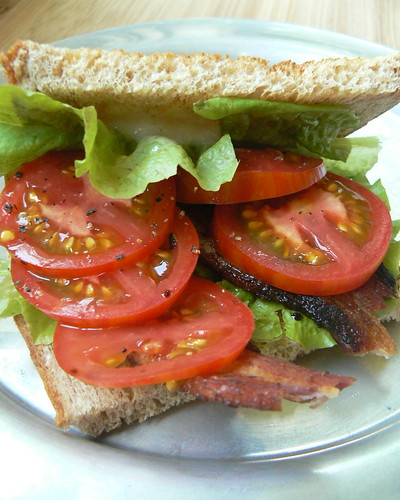
You could enter a BLT from scratch contest (or not)
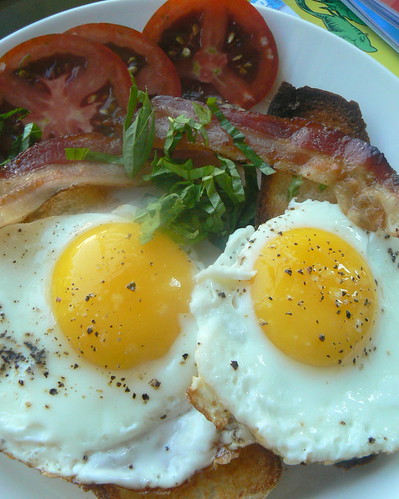
Eat it for breakfast,
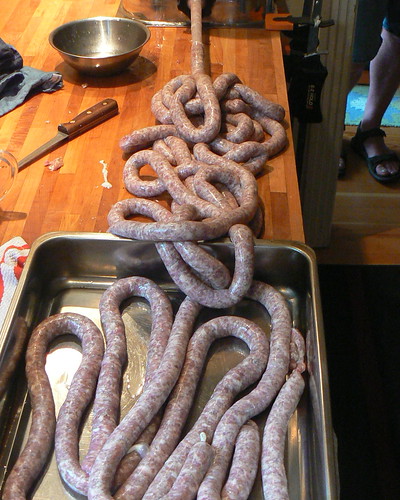
Or you can make bacon bratwurst.
Bacon works great in a supporting role too: Stews, beans, chili, meatloaf, pate, pizza, quiche. Bacon goes everywhere.

If you can't get you hands on pork belly, you can try a fatty piece of pork shoulder in the brine, I've done it a couple of times, it works well.
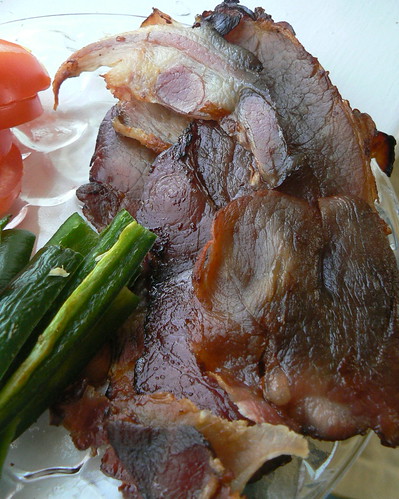
Whatever you do, make bacon, make it yours. If you have any questions please ask, I'm here to help.
Cheers.
02 July, 2009
Italian Style from SW Ohio
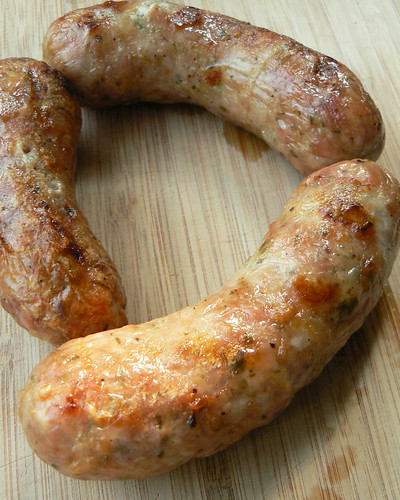
Italian Sausage recipe
A couple of years back a guy named George posted a comment that included a recipe for sausage. Well I finally got around to trying it out. Here's his recipe:
George’s Italian Sausage
INGREDIENTS
9 lb pork, boneless, shoulder or butt
3 Tbsp garlic powder
4 Tbsp fennel seed, partially ground in mortar
2 Tbsp red pepper
4 tsp salt
2 tsp pepper, black, freshly ground
2 Tbsp parsley, chopped
¼ cup white wine
Nine pounds is a lot of sausage, make sure you invite a few people over to eat it. The only change I made from the above recipe was in the quantity of salt. I'm not a big salter but I like about a teaspoon (7 g) of flake salt per pound of meat. Also I never been able to put too much parsley in a recipe.
So as America's biggest sausage holiday is upon us let's take time to reflect on what makes this country great: Sausage, made by hand and shared with others.
Thanks for the recipe, George.
Cheers.
05 March, 2009
Chicken Meatball
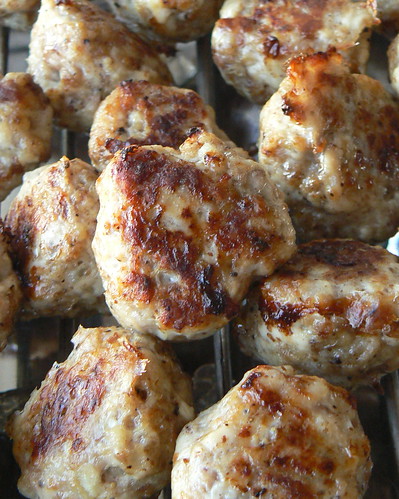
Everyone loves meatballs. Yesterday morning, on her way out the door, Bonne Femme asked if I had anything for her to make for dinner.
"Well I have half a chicken how about some meatballs?"
I came up with this recipe for a party last Christmas, but they are good anytime of the year.
Finnish Meatballs - Lihapullat
620g (1lb 5oz) Chicken. That's half a chicken, bones removed skin on.
8 g (1 t) Kosher salt
2 g black pepper
1 g allspice
Pinch of mace or nutmeg
Pinch of caraway seed
2 g mustard seed
5 g dried milk
90 g Onion diced
30 g of bread whole wheat or rye or whatever is laying around, torn up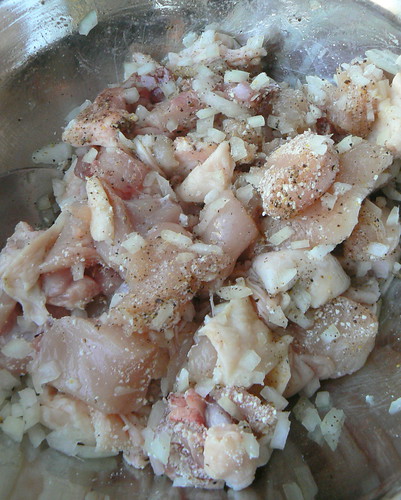
Dice the chicken. Process salt and spices as needed in spice mill. Mix together all ingredients in a bowl and refrigerate for an hour. Run the mixture through meat grinder using the small plate (I use the meat grinder attachment for the Kitchen Aid). If you don't have a grinder, you can do it by hand, read about making sausage without a grinder here. Knead the mixture in the bowl, by hand, until it comes together about one minute.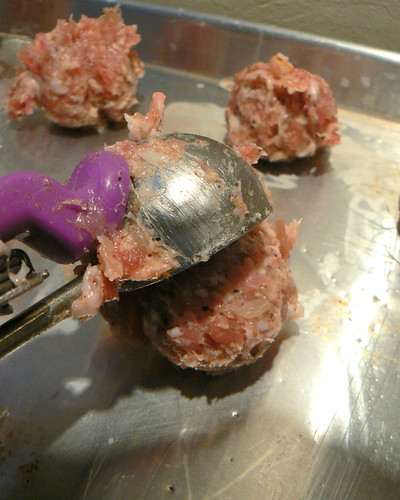
Preheat the oven to 400F. A portion scoop (that's a #40 pictured above) makes quick work of forming 1 oz meatballs, they are like ice cream scoppers of varying sizes that you can find at restaurant supply stores. Anyway, put em on a cookie sheet, using parchment paper makes things easier, but do whatever you want. Bake them for about 10 minutes.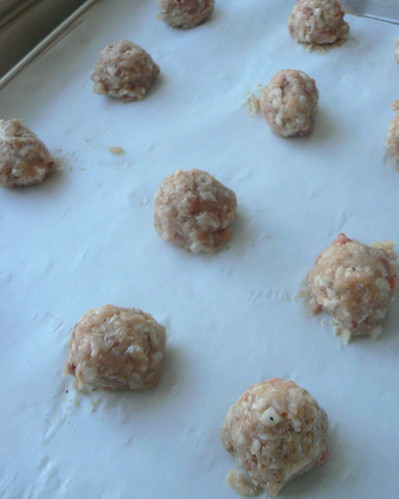
Let them cool on a rack. I made about 24 1oz meatballs. Once you get the hang of it play around with the seasonings. The dry milk helps retain moisture and the mustard works as an emusifier; together these ingredients make the texture light and juicy.
I decided to have a Finnish themed Christmas Party, a Pikkujoulu, after traveling to the Lapland last summer. I asked my Suomen sister-in-law for a recipe. she said "What do you mean? Just make meatballs."
I said "Ok...What's the difference between Swedish and Finnish meatballs?"
"The Finns don't eat Swedish meatballs."
Okay then.
Kippis.
25 February, 2009
Chorizo

Recipe for Chorizo.
What better way to learn about culture and food than by eating sausage. In today's episode, we take a little trip South of the border as I try to understand how two cultures came together to make this magical mixture, chorizo. Olé!
Chorizo is Spanish for sausage, and there are many kinds of chorizo ranging what we know as fresh chorizo, to Chorizo Verde, to a dry cured Spanish chorizo. In America we are most familiar with the fresh Mexican rojo (red) chorizo, a salty spicy sausage that comes in long pakages. My favorite way to eat it is for breakfast fried up in a hash with peppers and potatoes. But the store packaged stuff is nasty, I want a recipe that uses few ingredients and tastes like chorizo.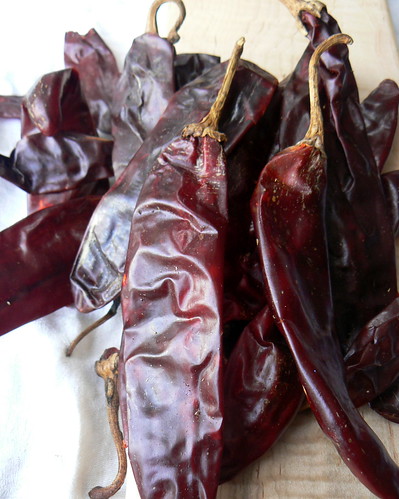
Chile Paste and the Aztec Blender.
The primary flavor for the chorizo is the chile (or chilli, or chili, or pepper). While I have made sausage in the past by just using powdered peppers, I believe you get a better flavor by preparing a chile paste from dried peppers. Here's how I learned to do it in school: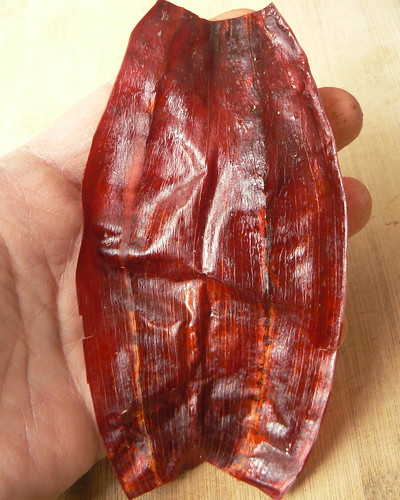
Remove the stems and seeds from the chiles.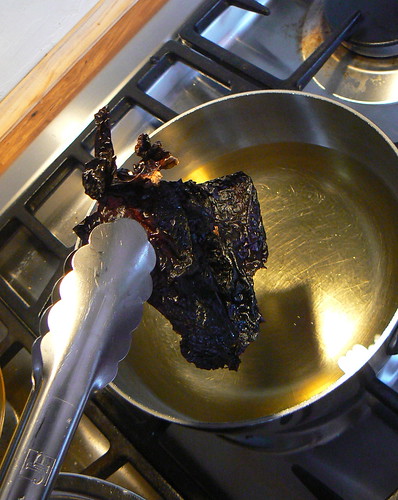
Blanch them in oil. No more than five seconds (really three), or they will they will burn, you'll get the hang of it. Make sure the oil is no more than 350F. Strain and save the chile oil.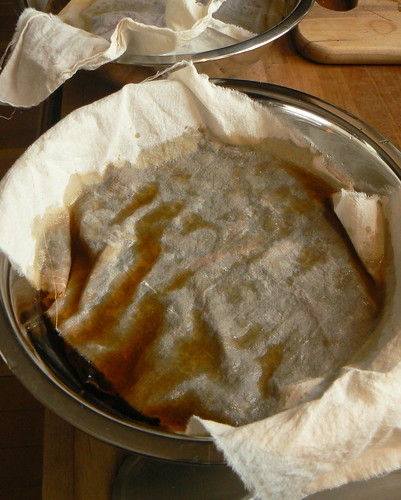
put the blanched chiles in hot tap water, cover with a paper towel and let them hydrate for ten minutes.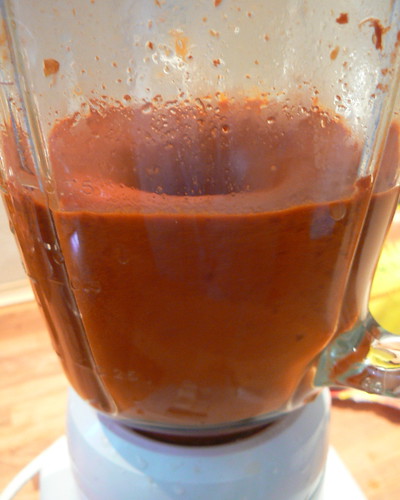
Discard the hydrating water, put the chiles in a blender, add about a cup of water (I started with 3oz (90g) of chiles) and puré. Strain the mixutre.
If you watch a lot of Rick Bayless, you might have noticed that the blender gets used a lot in the Cocina Mexicano.I have often wondered how did this stuff get made before the modern miracle of the West Bend. The Matate made it all possible. It's the three legged grinding stone that for centuries has been in the center of the Mexican kitchen. Up until the turn of the twentieth century a woman in the campesino would spend a third of her life grinding food (corn mostly) on the Matate, "The bitter black stone." Check out ¡Que vivan los tamales!: Food and the Making of Mexican Identity, by Jeffrey Pilcher for a history of the Mexican kitchen.
The meat of the matter.
So you've got your flavorful chile paste what about the meat? Before the Spanish showed up, there wasn't much meat in the Mexican diet, just turkey, iguana, insects and of course fish. With the conquistadors came Mestizo cuisine, a mixture of the two cultures, the Spanish introduced pork, beef and chicken along with rice, garlic and onion. The Spanish also introduced the art of making sausage. I read in Diana Kennedy's book, My Mexico: A Culinary Odyssey with More Than 300 Recipes, "Cortes introduced cattle and pork into the valley (Toluca, famous for sausage...(and) Spanish techniques for sausage making and pork curing naturally followed."
Okay so we have the Mexican Spanish food connection. Let's illustrate it in sausage.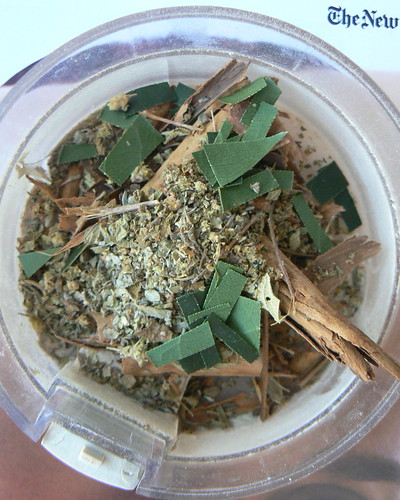
Herbas de olor.
Like the bouquet garni of French cooking, Mexican cuisine has amomatic herbs that serves as a seasoning base: Bay, thyme and marjoram make up the herbas de olor. In some Mexican groceries you can find these three fresh bunched together. I found these herbs in several Chorizo recipes so we will use a little bit. I would recommend trying to find fresh bunches, but in my final recipe I ended up using some dried. I also used some Mexican oregano (because I had some), if you don't have it I wouldn't worry about it too much. Mexican Oregano is not a part of the oregano/marjoram family it's actually related to Lemon Verbena.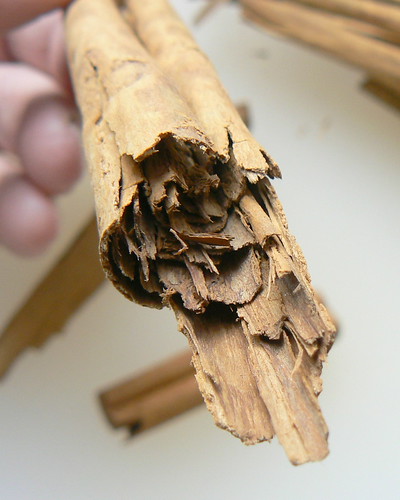
Canela - Cinnamon.
I have known for some time that what we typically call cinnamon is actually cassia, but I hadn't known the difference. In addition when I read recipes calling for "Cinnamon, preferably Mexican" I figured there's a third version from South of the border. Mexican cinnamon is actually true cinnamon and it's imported from Asia. The difference between cinnamon and cassia is dramatic: Cassia is blunt, cinnamon is light and sophisticated. Don't get me wrong, I wont be giving up my cassia for my cinnamon buns, but using Canela, true cinnamon, in moles or chorizo makes a world of difference.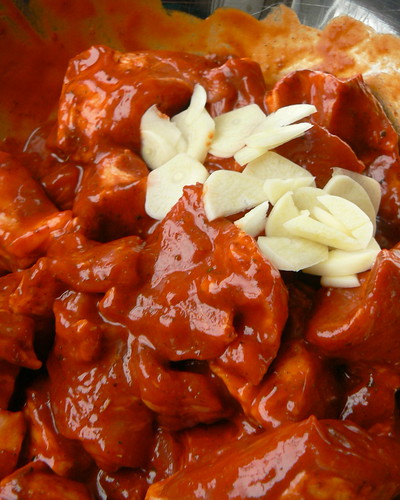
I made up two chiles pastes: guajillo and ancho. Bayless calls the guajillo the "workhorse" of Mexican cuisine, but I would guess the ancho is the most widely used. The guajillo gives beautful color, the ancho provides rich undertones, along with the spices and some garlic, I marinate the pork for an hour.
I made several batches using various combinations of ingredients, I even did a batch with added fat,but I wanted to keep things as simple as possible so I left out the added fat. In all I made about ten pounds of sausage over the past four days.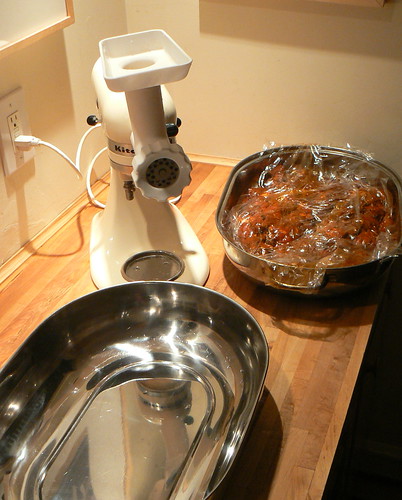
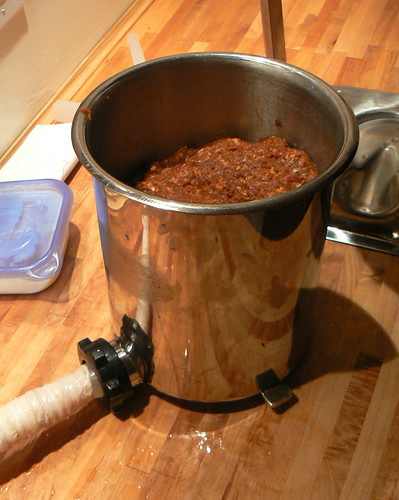
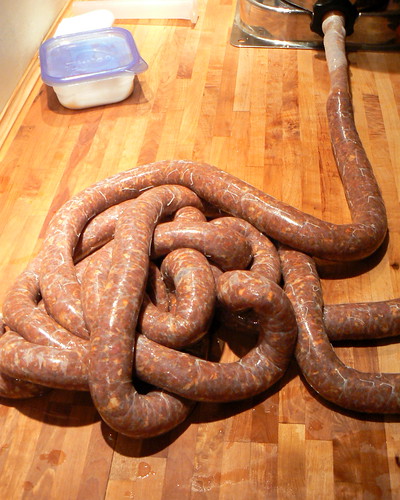
Here's the recipe:
450 g (1 lb) pork shoulder cubed
60g (2oz) Chile paste (I used 50/50 guajillo/ancho, see above for paste instructions)
2 cloves (10 g) of garlic minced.
8 g (1 teaspoon) Salt
4 g cinnamon (for cassia use less, see above)
2 fresh bay leaves minced
1 g dried thyme
1 g dried marjoram
1 g dried Mexican oregano
15 ml (1 Tablespoon) Cider vinegar
Combine cubed pork, chile paste, and garlic. Process salt, herbs and spices in a spice mill and add to mixture. After a rest, run the mass through a grinder. Kneed it adding the vinegar until it starts to come together, about one minute. Stuff into hog casings for that loganzia look.
Chorizo is cooked without a casing, use it for breakfast or for stuffing peppers or for whatever. Enjoy. I gotta get to class.
Cheers.

